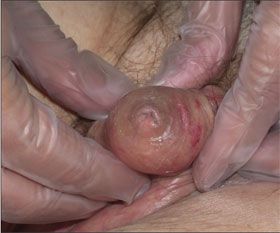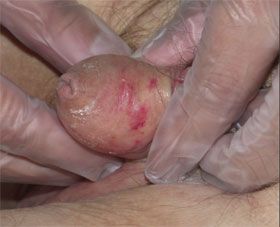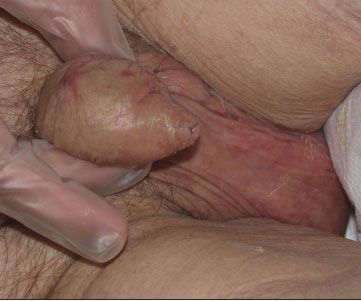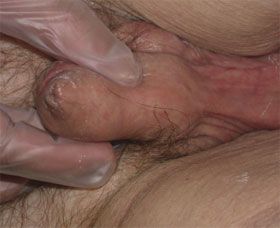- Clinical Technology
- Adult Immunization
- Hepatology
- Pediatric Immunization
- Screening
- Psychiatry
- Allergy
- Women's Health
- Cardiology
- Pediatrics
- Dermatology
- Endocrinology
- Pain Management
- Gastroenterology
- Infectious Disease
- Obesity Medicine
- Rheumatology
- Nephrology
- Neurology
- Pulmonology
Aged Man With Disfigured Tip of Penis
An 83-year-old man examined on admission for end-of-life care due to profound dementia. His wife states that his penis has not changed in appearance, but knows that he always had concerns about it. To her knowledge he never had trouble voiding. Patient too impaired to discuss any topic coherently. Wife considers it unlikely he would have disclosed any symptom of this type to her.

HISTORY
An 83-year-old man examined on admission for end-of-life care due to profound dementia. His wife states that his penis has not changed in appearance, but knows that he always had concerns about it. To her knowledge he never had trouble voiding. Patient too impaired to discuss any topic coherently. Wife considers it unlikely he would have disclosed any symptom of this type to her.
PHYSICAL EXAMINATION
Markedly demented man. Does not show psychic or physical distress in his facial expression, body posture, or tone of his nonverbal vocalizations. No pressure ulcers. Several scabbed areas on shins from bumping into things due to absent safety awareness and poor muscular control. Breathing easy and quiet, no gurgling on secretions. Penis as shown.
WHAT’S YOUR DIAGNOSIS? (Answer on next page.)
ANSWER: PHIMOSIS
The examiner’s index fingers and thumbs not only hold the penis in place, they are tugging to attempt retraction of the prepuce, without success. Hence we diagnose phimosis, synonymous with non-retractable foreskin.1 In the Kikiro classification2 this case accords with the most severe level,5 whereby neither meatus nor glans can be exposed, and no retraction whatever is achieved.

The preputial orifice-the normal opening of the foreskin through which the glans should protrude- looks tiny. That might be taken as prima facie evidence of phimosis, but sometimes one is surprised when an especially elastic prepuce moves back allowing inspection of the glans.

Small ecchymoses dot the left side of the foreskin (Figure 1). We do not know what caused them: there had been no forceful gripping to try to reduce the phimosis or to place or remove a urethral catheter; nor did the patient masturbate or have sex. The platelet count was minimally reduced. There were no similar lesions elsewhere on the skin or mucous membranes. Nor was there any other sign of injury on penis or scrotum (Figures 2 and 3).

PHIMOSIS VERSUS PARAPHIMOSIS
Both phimosis and paraphimosis involve a prepuce and orifice that are too small for the glans. Phimosis, in which the skin is in the “forward position” overlying the glans, is well tolerated unless the urine lacks proper egress or hygiene is compromised. In paraphimosis, the skin sits backward and acts as a constricting band, preventing venous and lymphatic return from the glans. This leads to edema of glans and shaft distal to the site of the constricting foreskin. As a result, the size disproportion is exacerbated and self-correction becomes impossible. In the extreme, without medical intervention, venous infarction of the distal penis may follow; this is why paraphimosis is a urological emergency whereas phimosis is not.3,4
WHAT ARE SOME CAUSES?
The embryology and life cycle of the foreskin are well delineated.5 Some boys are born with a too-small preputial orifice; others lack the expected childhood reduction in adherence between layers of foreskin.5 Many boys and men develop adhesions and scarring due to infection, whether with Candida species, anaerobic bacteria, herpesviruses, sexually transmitted pathogens, or unusual organisms.1,6-8 Infection can cause phimosis; but phimosis also creates a closed space and thus predisposes to balanitis and posthitis.
A large subset of cases of phimosis result from sterile inflammation, whether traumatic,9 from frostbite,10 iatrogenic from radiotherapy,11 mechanical,12 or via the immunological condition balanitis xerotica obliterans, a localized penile variant of lichen sclerosus et atrophicus.13 The newest inflammatory trigger to phimosis is bone marrow transplant, perhaps via late scarring due to graft-versus-host disease.14
A relationship is reported between recent-onset phimosis in adults and diabetes mellitus.15 Several such patients had antecedent recurrent balanitis; another subset showed fissures of the foreskin: so the connection may be that diabetes predisposes to bacterial infection or mycosis of moist areas, and that the resultant inflammation and scarring creates phimosis.
The architecture of the penis predisposes to obstruction following injury: not only does the glans ordinarily vary in position relative to the foreskin, but also the entire penis has to accommodate substantial transient enlargement with each penile erection. Little wonder, then, that some patients’ symptoms first become noticeable on sexual excitement.
WHEN IS INTERVENTION REQUIRED?
Very often, observation alone suffices as management of phimosis. Progression can warrant change to preempt worsening symptoms or cosmesis. Discomfiture, including psychological upset, calls for considering intervention. Many men dislike a phimotic appearance. Conversely, some Japanese men avoid circumcision for fear of its producing a 2-tone color change, to which Asian men seem particularly susceptible, that could embarrass them in a public bath.16
Recurrent symptomatic infections such as balanoposthitis require taking measures. So does any concern that cancer is lurking, invisible and thus undiagnosable, eg, with a lump under the foreskin or unexpected new phimosis in an older man. A mass would suggest late, advanced carcinoma or some less ominous condition such as Peyronie disease.
The most dramatic complication of phimosis is renal failure due to obstructive uropathy. One such case17 showed perfect recovery of renal function after relief of all obstruction and meticulous urological internal reconstruction. One envisions that any such patient waiting far too long to seek medical attention would wind up on lifetime dialysis.
At a minimum, one needs to consider obstruction in any man or boy with phimosis who reports that when he voids, the foreskin balloons before the urine exits to the toilet bowl. One has to ask bluntly: embarrassment ensures that such information is unlikely to be volunteered after an open-ended question.
ARE THERE ALTERNATIVES TO SURGERY?
As with paraphimosis, circumcision sounds like a cure-all. But once again, a host of other measures have been devised and often achieve excellent results. Most involve repetitive retraction of the foreskin to break adhesions and to stretch the area18-capitalizing on the elasticity of skin in general and penile skin in particular- or the use of anti-inflammatory agents, or most often a combination of the two.2,19 The placebo arm of one such study, in which moisturizer was applied instead of the corticosteroid mometasone along with a program of parental stretching of boys’ phimotic foreskins, showed a 50% rate of resolution.
ROLE OF HISTOPATHOLOGICAL EVALUATION
One might envision that the pathologist’s histological examination of the prepuce would disclose some clinically unsuspected carcinomas, since occult cancers are sometimes found in hernia sacs and hemorrhoids. The frequency of incidental discovery of squamous cancer of the foreskin is low, and lowest in boys and men whose circumcision is routine, whether performed for religious reasons or even for phimosis.20,21
Surprisingly, many foreskins from men with highly symptomatic phimosis show no scarring or inflammation at all, 20,21 re-emphasizing that some phimoses result purely from disproportion between size of glans/distal shaft and preputial orifice.
Discovery on histopathology of the inflammatory condition balanitis xerotica obliterans provides useful assistance by identifying a subgroup most at risk for subsequent meatal stenosis. Many such cases have already been recognized preoperatively by a urologist.
ROLE OF CLINICAL EVALUATION
One report describes a patient whose phimosis was discovered by review of his bone-scan images: voided radioactive tracer had pooled in the phimosis, mimicking a feared neoplastic involvement of the pelvic bones.22 The authors write, “We initially thought that the patient’s clothes were contaminated with radioactive urine,” which strongly suggests that nobody looked at the penis until the high-tech test justified a physical examination (rather than the other way round). Worse, had the radiologist been less astute, the condition might have been misdiagnosed as metastatic disease, bringing drastic attendant deterioration in prognosis, psychological devastation, and commencement of unnecessary and toxic antineoplastic therapy. I hope that readers of the column will not think me a broken record, harsh, or a Luddite when I reiterate, both about this particular case and about taking care of human beings in general, “No genius required: just look and see what is there.”
Schneiderman H. Phimosis: recognition, differential diagnosis, management. CONSULTANT. 2009;49:186-192
References:
REFERENCES: 1. Fox E. Phimosis. Practitioner. 1997;241(1578):534.
2. Pileggi F de O, Vicente YA. Phimotic ring topical corticoid cream (0.1% mometasone furoate) treatment in children. J Pediatr Surg. 2007;42:1749-1752.
3. Schneiderman H. Paraphimosis in a man with a urethral catheter: the mimics of paraphimosis; and its many remedies. Consultant. 2004;44:275-281.
4. Choe JM. Paraphimosis: current treatment options. Am Fam Physician. 2000;62:2623-2626, 2628.
5. Lawless MR, Serwint JR. The foreskin. Pediatr Rev. 2006;27:477-478.
6. Tokgoz H. Preputial bacterial flora and its relation with phimosis. Urol Int. 2006;76:192.
7. White C, Sparks RA. Prepucial occlusion and circumcision after genital herpes infection. Int J STD AIDS. 1991;2:209-210.
8. Ariyanayagam-Baksh SM, Baksh FK, Cartun RW, Sieber PR. Histoplasma phimosis: an uncommon presentation of a not uncommon pathogen. Am J Dermatopathol. 2007;29:300-302.
9. Yip A, Ng SK, Wong WC, et al. Injury to the prepuce. Br J Urol. 1989;63:535-538.
10. Myhre U, Goode PN, Miller IA. Jogger’s phimosis. Br J Urol. 1989;63:549.
11. Featherstone JM, Aldridge A, Gudgeon AM. Radiotherapy for rectal carcinoma: an unusual cause of foreskin phimosis. Int Urol Nephrol. 2006;38:603-605.
12. Yuasa T, Kageyama S, Yoshiki T, Okada Y. Preputial calculi: a case report. Hinyokika Kiyo. 2001;47:513-515.
13. Neuhaus IM, Skidmore RA. Balanitis xerotica obliterans and its differential diagnosis. J Am Board Fam Pract. 1999;12:473-476.
14. Suzuki D, Kobayashi R, Kaneda M, et al. Severe phimosis as a notable sequela of allogeneic stem cell transplantation in boys. Bone Marrow Transplant. 2007;40:335-338.
15. Chopra R, Fisher RD, Fencl R. Phimosis and diabetes mellitus. J Urol. 1982;127:1101-1102.
16. Ohjimi H, Ogata K, Ohjimi T. A new method for the relief of adult phimosis. J Urol. 1995;153:1607-1609.
17. Rosenberg JW. Phimosis: a cause of renal failure. J Med Soc N J. 1983;80:845-846.
18. Dunn HP. Non-surgical management of phimosis. Aust N Z J Surg. 1989;59:963.
19. Zampieri N, Corroppolo M, Camoglio FS, et al. Phimosis: stretching methods with or without application of topical steroids? J Pediatr. 2005;147:705-706.
20. Clemmensen OJ, Krogh J, Petri M. The histologic spectrum of prepuces from patients with phimosis. Am J Dermatopathol. 1988;10:104-108.
21. Pearce I, Payne SR. Do men having routine circumcision need histological confirmation of the cause of their phimosis or postoperative follow-up? Ann R Coll Surg Engl. 2002;84:325-327.
22. Lim ST, Sohn MH, Kwak JY, Yim CY. Phimosis revealed by contamination with radioactive urine on bone scintigraphy. Clin Nucl Med. 2001;26:972.
No Rx Required for COVID-19 Vaccination But ACIP Calls for Better Informed Consent Process
September 22nd 2025The ACIP on September 19 narrowly voted against requiring a prescription to get the shot but urged more detailed discussion of vaccine risks during shared decision making conversations.
